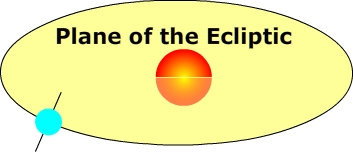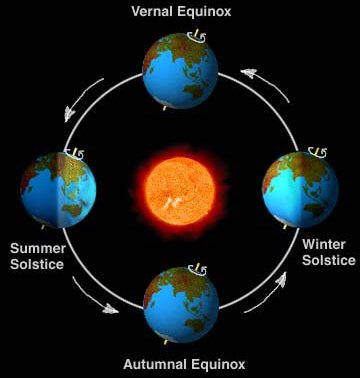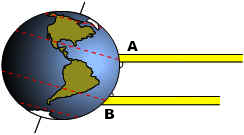|
Earth
System

Figure 2.10 Plane of the
Ecliptic
The plane of the ecliptic
(also known as the "Earth-Sun plane") is a plane that
cuts through the center of the Earth and the Sun in
which the Earth revolves around the Sun. The Earth's
axis of rotation (called the "axial
tilt") is tilted 23 1/2
degrees from being perpendicular to the plane of the
ecliptic. The axis remains pointing in the same
direction as the Earth revolves around the Sun,
pointing toward the star Polaris. As a result, the
Earth's axis of rotation remains parallel to its
previous position as it orbits the sun, a property
called "parallelism".

Figure 2.11 Orientation of
Earth to Sun
Courtesy NASA (Source)
The constant tilt and parallelism causes
changes in the angle that a beam of light makes with
respect to a point on Earth during the year, called
the "sun
angle". The most intense
incoming solar radiation occurs where the sun's rays
strike the Earth at the highest angle. During the
summer months the Earth is inclined toward the Sun
yielding high sun angles. During the winter, the Earth
is oriented away from the Sun creating low sun
angles.
 Figure
2.12 Effect of axial tilt on incoming
solar radiation Figure
2.12 Effect of axial tilt on incoming
solar radiation
Figure 2.24 shows the orientation of
Earth with respect to the Sun during the northern
hemisphere summer and its affect on sun angle. The
dashed lines are the Tropic of Cancer (23.5oN)
and Tropic of Capricorn 23.5oS). The
northern hemisphere is tilted into the sun yielding a
higher angle (A) and warmer temperatures than in the
southern hemisphere were low angle sun angles are
striking (B).
Previous
| Continue
|